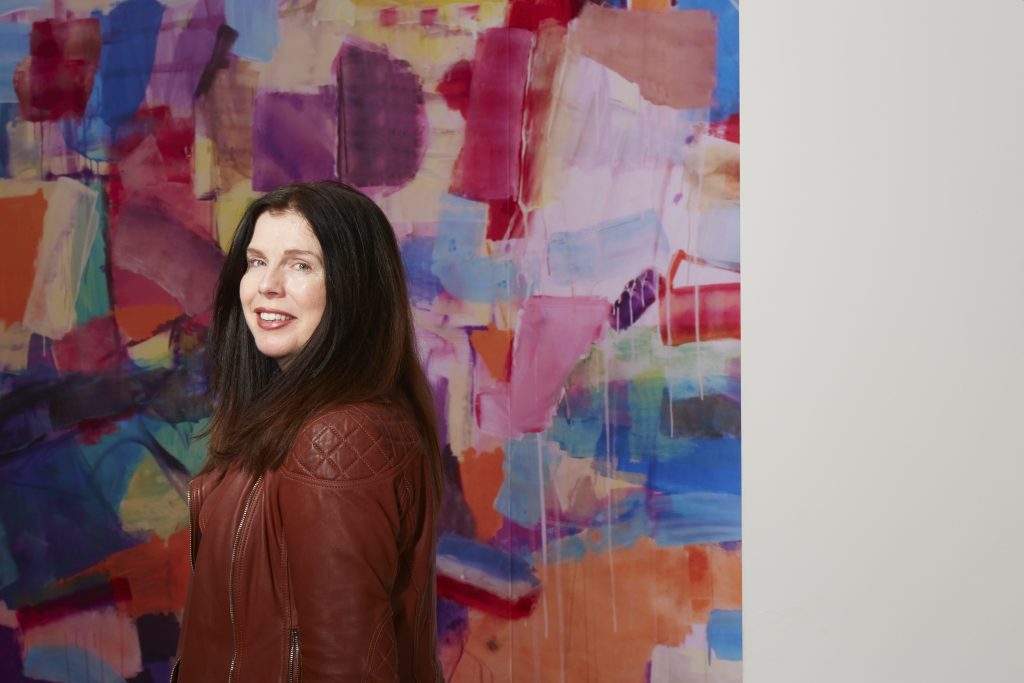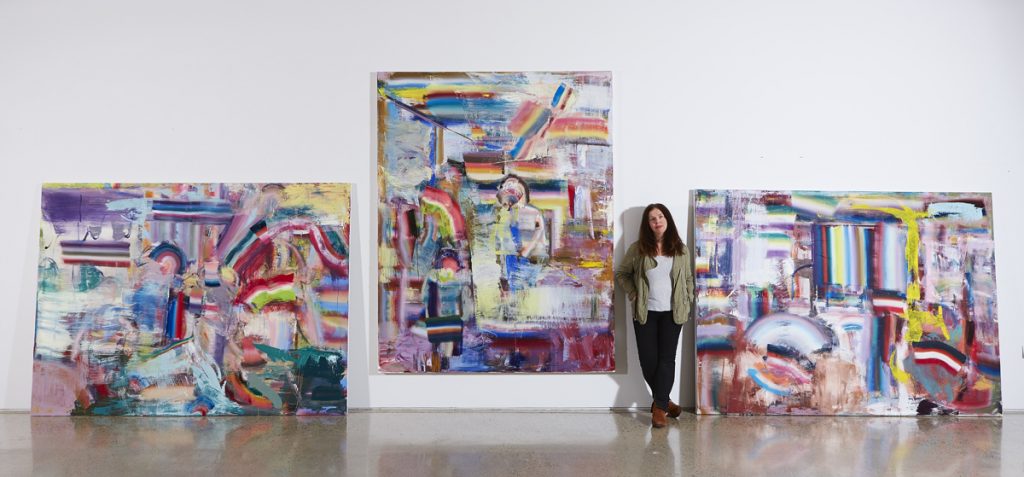
Anatomy of time

online exhibition

Diana Copperwhite-The Brooklyn Rail
https://brooklynrail.org > artseen >Diana-Copperwhite-The-Clock-Struck-Between-Time
For the 2019 edition of Galway International Arts Festival, 126 Artist-run Gallery presents “Reforming” a duo exhibition by acclaimed Irish artist Diana Copperwhite and emerging Irish artist Ciara Barker. Reforming presents an exhibition infused with colour which explores notions of reality, abstraction and our sense of space, while placing two artists at different stages of career together. Admission is free and all are welcome.
“Copperwhite’s work focuses on how the human psyche processes information, and looks at the mechanisms of how we formulate what is real. With her work, she is fully aware that such realities may only hold validity for an instant, and that we are constantly processing and changing what we logically hold as experience and memory. Layering fragmented sources that range from personal memory to science, from media and internet to personal memory, Copperwhite’s canvases become worlds in which the real is unreal and this unreality is in a constant state of reforming.”-Noel Kelly, Director of Visual Artist Ireland, (2011)
The wall print (Anatomy of time 3) is made using footage from mobile phone cameras sent by anonymous individuals and some friends in Galway. Taking 30 seconds as my only que, I looked and responded to the short films by quickly drawing the contours and shapes of fleeting images seen to create a composite of abstract pattern. This pattern was then taken, photographed and blown up to creat a 21 foot long x12 foot tall digital print. Essentially taking the tradition of mural painting and bringing its epic proportions back down to the mobile phone.
Diana Copperwhite (b. 1969, Ireland) lives and works in Dublin and New York. Recent solo exhibitions include Driven by Distraction, Royal Hibernian Academy, Dublin (2016), Depend on the Morning Sun, Thomas Jaeckal Gallery, New York (2016) and A Million and One Things Under the Sun, Kevin Kavanagh, Dublin (2015). Selected group exhibitions include Last Picture Show w/Mary Heilmann, Chris Ofili, Danny Rolph, Vanessa Jackson, Elio Rodriguez, Jill Levine, Rebecca Smith, Thomas Jaeckel Gallery, New York (2017) and Virtú, inc. Picasso, Giacometti, Henry Moore, Elizabeth Magill and Sean Scully at the Hunt Museum, Limerick, Ireland (2017). Copperwhite’s work is held in numerous public and private collections including: the Irish Museum of Modern Art, Arts Council of Ireland, Limerick City Gallery of Art, Office of Public Works, Contemporary Irish Art Society, Highlanes Municipal Art Gallery, Mariehamn Stadbiblioteque, Aland (Finland), Dublin Institute of Technology and The President of Ireland.
TULCA Festival of Visual Arts is pleased to announce the programme for this year’s iteration of the festival, TACTICAL MAGIC curated by Kerry Guinan, 1-17 November 2019.
Now in its 17th year, TULCA Festival of Visual Arts is a multi-venue, artist-centred festival of contemporary art in Galway City and County. The festival works with Ireland-based curators to present innovative exhibitions that provoke and energise audiences into the world of the Visual Arts.
TACTICAL MAGIC explores the theme of magic as it manifests in art, politics, and the sciences. Magic is herein understood as a practical, or tactical, device that allows us to control our reality. The Curator has taken inspiration from West of Ireland folklore to propose magic as a valuable intuitive practice, worthy of preservation in a securalising society.
To this end TULCA is delighted to share this year’s exciting programme of exhibitions and events, comprising 15 contemporary artists, 4 specifically commissioned projects, and 12 associated events across 14 venues in Galway. These include a socially-engaged commission by artist and folklore collector Michael Fortune in collaboration with the Skehana and District and Heritage Group, a large-format public art commission by Dublin collective SUBSET, and a new partnership and exhibition with Galway City Museum. Events range from an all-ages Weather-Reading workshop with Nikita Coulter in Nun’s Island Theatre to a black-metal-noise performance by the Bogs of Aughiska in the Roisin Dubh.
TULCA’s main festival gallery will be centrally located in the former An Post sorting facility off William Street, recently refurbished into an exhibition space by Galway International Arts Festival. Other venues include NUIG Gallery, Columban Hall, 126 Artist-run Gallery, Palas Cinema, The Hall of the Red Earl, Galway Arts Centre, Galway City Museum, Tuam Library / County Council Building, and Engage Art Studios Gallery.
“TACTICAL MAGIC sees art as a magical tool that allows us to access and create realities beyond our own. I am thrilled to announce a diverse programme of exhibitions and events which supports this theme and to welcome these excellent artists to Galway ” Curator Kerry Guinan.
TULCA Festival of Visual Arts is kindly supported by the Arts Council of Ireland, Galway City Council and Galway County Council.
April 30 – June 1, 2019.
Chelsea, New York: 532 Gallery Thomas Jaeckel is very honored to present Diana Copperwhite’s, The Clock Struck between Time, from April 30 to June 1, 2019. The opening reception is on Tuesday, April 30 from 6pm to 8pm, with the artist in attendance.
Copperwhite, who is based in Dublin, in these new paintings expands upon her concerns of figuration, abstraction, and representation with references both to time as it is observed and counted and to the temporality of music and memory. Her arresting critical approach to abstraction by way of a “computer-inflected visuality,” as suggested by Stephen Maine in his Hyperallergic 2017 review, suggests reality is a pliant screen and evokes the instability of images and the fragility of memories as metaphors for the precariousness of our present realities.
10 OCTOBER – 9 NOVEMBER 2019
Link to text written by Chris Clarke
2018 Prism, The Art and Science of Light, The Glucksman Gallery, UCC, Cork, Ireland
30 November 2018 – 10 March 2019
The Glucksman University College Cork
Artists: Polly Apfelbaum, David Batchelor, Alan Butler, James Clar, Diana Copperwhite, Jenny Holzer, Mark Joyce, Brigitte Kowanz, Dennis McNulty, Emer O’Boyle, and Grace Weir
Curated by Chris Clarke and Fiona Kearney in association with the Irish Photonic Integration Centre at the Tyndall Institute, UCC
Light is often thought as being comprised of the single colour of white. However, white light, when observed through a prism, can be seen to consist of many colours. PRISM: The art and science of light is an exhibition of Irish and international artists that takes as its starting point Isaac Newton’s observation of the visible spectrum, exploring light and the ways in which it has been used as subject matter and artistic medium. Light-enabled technologies underpin the internet and among its research areas, IPIC at the Tyndall Institute advances energy efficient ways of transmitting, storing and displaying information. PRISM presents artworks that record and investigate how light shapes our world.
Mark Joyce uses his knowledge of lenses, spectroscopes and other instruments to create works that illuminate fundamental aspects of light, with his abstract paintings making reference to Newton’s colour wheel as well as to modernist painting. David Batchelor’s practice has long investigated the luminescent qualities of colour. A hanging bundle of low-energy bulbs encased in recycled household plastics gently illuminates a gallery window with the colours of the spectrum, while his wall sculpture Glowstick 7 is a vibrant and sharply angular composition of
coloured light. Emer O’Boyle’s installation is inspired by Cecilia Payne Gaposchkin who discovered the constitution of stars in 1925. Her chandelier of 603 coloured test tubes, each inscribed with the individual signature of University College Cork staff and students, reflects the university’s commitment to gender equality in the sciences.
Light illuminates space, as well as connecting us to the universe and each other. US based artist, Polly Apfelbaum’s new work Free Form Planets comprises an installation of rainbow- coloured discs, scattered across the gallery walls recalling both otherworldly satellites, glowing orbs and colour wheel charts. Her Hudson River Valley Nirvana woodblock prints refer to the dynamic skies captured by the Hudson River School painters in the mid-19th century as well as to the more psychedelic effects of Op Art. Diana Copperwhite’s painting Radiator depicts a spectrum of brilliant colours that glow from within a field of darkness and her densely layered, abstract paintings offer a more psychological take on perception, focusing on how we process information and formulate reality, by drawing on personal memory, found imagery and fleeting, fragmentary impressions.
Much like the spectrum of colour that becomes visible when white light is filtered through a prism, Grace Weir’s film installation uses a single artwork to present an array of historical and scientific associations. A reflection on light weaves different moments relating to the
Irish modernist artist Mainie Jellett’s painting Let there be light. From photographs of the interior of Jellett’s Dublin apartment to the notebooks of her grandfather, a scientist and researcher on polarised light at Trinity College Dublin, to the hanging of the artwork in the School of Physics in Trinity.
Artists are quick to adopt new technologies in their work and light-emitting diodes, better known as LEDs, have been used in artworks soon after they were invented in 1962. In Dennis McNulty’s Running up that building, a sheet of foil-backed plasterboard sits against the corridor wall, its reflective surface drawing the viewer in to witness a subtle text transmitted through LED. James Clar’s Triple Oscillation uses LEDs to create overlapping lines of coloured light in a kaleidoscopic looping pattern, suggesting a continuously unfolding form.
The US artist Jenny Holzer uses LED displays to convey her Truisms, an ongoing series of short sayings that communicate viewpoints that are in turns comic, provocative, and insightful. Her
work crosses over between large scale presentations in the public domain such as Times Square in New York, to installations in museums worldwide such as the 4 metre high column of alternating blue and white LED displays in the Glucksman.
The graphics of a computer screen are generated through different combinations of red, green and blue light. Alan Butler’s paintings take their form from the landscape photographs that come with modern computer operating systems, with the pixels of digital imagery transferred into colours from the visible spectrum. The medium of light is central to Brigitte Kowanz’ work. The artist sketches a relevant word such as Immersion or uses Morse code to reference an important date in digital history, here the date YouTube went online. These referents are placed between two mirrors to create an illusion of infinite space, inviting us to think about how
easily we become immersed in the digital world
The ideas and experiences of PRISM will be extended into an imaginative season of public activities including maker workshops, art/science talks, art courses, family events, teacher masterclasses and a schools programme supported with online resources.
PRISM is supported by University College Cork, The Arts Council Ireland, and private philanthropy through Cork University Foundation.
It is possible to arrange for press interviews with some of the participating artists. For further discussion of the exhibition, press images or more detailed information, please contact:
Chris Clarke, Senior Curator, The Glucksman, University College Cork.

Diana Copperwhite is a painter who explores the relationship between colours, gestures, figuration and representation. Copperwhite amalgamates images from the internet, photographs, and real life, unifying these sources in paintings that critically assess the medium’s ability to represent images, sensations, and ideas. For dlr Lexicon she will show paintings and a large wall installation. The pattern for the wall piece is derived from an on-going series of random images and videos sent to her by people in the Dún Laoghaire area.